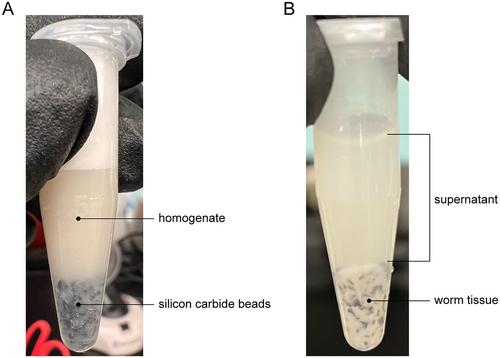Lakshmi E. Batachari, Mario Bardan Sarmiento, Nicole Wernet, Emily R. Troemel
{"title":"奥赛病毒感染秀丽隐杆线虫。","authors":"Lakshmi E. Batachari, Mario Bardan Sarmiento, Nicole Wernet, Emily R. Troemel","doi":"10.1002/cpz1.1098","DOIUrl":null,"url":null,"abstract":"<p>Orsay virus infection in the nematode <i>Caenorhabditis elegans</i> presents an opportunity to study host-virus interactions in an easily culturable, whole-animal host. Previously, a major limitation of <i>C. elegans</i> as a model for studying antiviral immunity was the lack of viruses known to naturally infect the worm. With the 2011 discovery of the Orsay virus, a naturally occurring viral pathogen, <i>C. elegans</i> has emerged as a compelling model for research on antiviral defense. From the perspective of the host, the genetic tractability of <i>C. elegans</i> enables mechanistic studies of antiviral immunity while the transparency of this animal allows for the observation of subcellular processes in vivo. Preparing infective virus filtrate and performing infections can be achieved with relative ease in a laboratory setting. Moreover, several tools are available to measure the outcome of infection. Here, we describe workflows for generating infective virus filtrate, achieving reproducible infection of <i>C. elegans</i>, and assessing the outcome of viral infection using molecular biology approaches and immunofluorescence. © 2024 The Authors. Current Protocols published by Wiley Periodicals LLC.</p><p><b>Basic Protocol 1</b>: Preparation of Orsay virus filtrate</p><p><b>Support Protocol</b>: Synchronize <i>C. elegans</i> development by bleaching</p><p><b>Basic Protocol 2</b>: Orsay virus infection</p><p><b>Basic Protocol 3</b>: Quantification of Orsay virus RNA1/RNA2 transcript levels by qRT-PCR</p><p><b>Basic Protocol 4</b>: Quantification of infection rate and fluorescence in situ hybridization (FISH) fluorescence intensity</p><p><b>Basic Protocol 5</b>: Immunofluorescent labeling of dsRNA in virus-infected intestinal tissue</p>","PeriodicalId":93970,"journal":{"name":"Current protocols","volume":"4 7","pages":""},"PeriodicalIF":0.0000,"publicationDate":"2024-07-05","publicationTypes":"Journal Article","fieldsOfStudy":null,"isOpenAccess":false,"openAccessPdf":"https://onlinelibrary.wiley.com/doi/epdf/10.1002/cpz1.1098","citationCount":"0","resultStr":"{\"title\":\"Orsay Virus Infection in Caenorhabditis elegans\",\"authors\":\"Lakshmi E. Batachari, Mario Bardan Sarmiento, Nicole Wernet, Emily R. Troemel\",\"doi\":\"10.1002/cpz1.1098\",\"DOIUrl\":null,\"url\":null,\"abstract\":\"<p>Orsay virus infection in the nematode <i>Caenorhabditis elegans</i> presents an opportunity to study host-virus interactions in an easily culturable, whole-animal host. Previously, a major limitation of <i>C. elegans</i> as a model for studying antiviral immunity was the lack of viruses known to naturally infect the worm. With the 2011 discovery of the Orsay virus, a naturally occurring viral pathogen, <i>C. elegans</i> has emerged as a compelling model for research on antiviral defense. From the perspective of the host, the genetic tractability of <i>C. elegans</i> enables mechanistic studies of antiviral immunity while the transparency of this animal allows for the observation of subcellular processes in vivo. Preparing infective virus filtrate and performing infections can be achieved with relative ease in a laboratory setting. Moreover, several tools are available to measure the outcome of infection. Here, we describe workflows for generating infective virus filtrate, achieving reproducible infection of <i>C. elegans</i>, and assessing the outcome of viral infection using molecular biology approaches and immunofluorescence. © 2024 The Authors. Current Protocols published by Wiley Periodicals LLC.</p><p><b>Basic Protocol 1</b>: Preparation of Orsay virus filtrate</p><p><b>Support Protocol</b>: Synchronize <i>C. elegans</i> development by bleaching</p><p><b>Basic Protocol 2</b>: Orsay virus infection</p><p><b>Basic Protocol 3</b>: Quantification of Orsay virus RNA1/RNA2 transcript levels by qRT-PCR</p><p><b>Basic Protocol 4</b>: Quantification of infection rate and fluorescence in situ hybridization (FISH) fluorescence intensity</p><p><b>Basic Protocol 5</b>: Immunofluorescent labeling of dsRNA in virus-infected intestinal tissue</p>\",\"PeriodicalId\":93970,\"journal\":{\"name\":\"Current protocols\",\"volume\":\"4 7\",\"pages\":\"\"},\"PeriodicalIF\":0.0000,\"publicationDate\":\"2024-07-05\",\"publicationTypes\":\"Journal Article\",\"fieldsOfStudy\":null,\"isOpenAccess\":false,\"openAccessPdf\":\"https://onlinelibrary.wiley.com/doi/epdf/10.1002/cpz1.1098\",\"citationCount\":\"0\",\"resultStr\":null,\"platform\":\"Semanticscholar\",\"paperid\":null,\"PeriodicalName\":\"Current protocols\",\"FirstCategoryId\":\"1085\",\"ListUrlMain\":\"https://onlinelibrary.wiley.com/doi/10.1002/cpz1.1098\",\"RegionNum\":0,\"RegionCategory\":null,\"ArticlePicture\":[],\"TitleCN\":null,\"AbstractTextCN\":null,\"PMCID\":null,\"EPubDate\":\"\",\"PubModel\":\"\",\"JCR\":\"\",\"JCRName\":\"\",\"Score\":null,\"Total\":0}","platform":"Semanticscholar","paperid":null,"PeriodicalName":"Current protocols","FirstCategoryId":"1085","ListUrlMain":"https://onlinelibrary.wiley.com/doi/10.1002/cpz1.1098","RegionNum":0,"RegionCategory":null,"ArticlePicture":[],"TitleCN":null,"AbstractTextCN":null,"PMCID":null,"EPubDate":"","PubModel":"","JCR":"","JCRName":"","Score":null,"Total":0}
引用次数: 0
Orsay Virus Infection in Caenorhabditis elegans
Orsay virus infection in the nematode Caenorhabditis elegans presents an opportunity to study host-virus interactions in an easily culturable, whole-animal host. Previously, a major limitation of C. elegans as a model for studying antiviral immunity was the lack of viruses known to naturally infect the worm. With the 2011 discovery of the Orsay virus, a naturally occurring viral pathogen, C. elegans has emerged as a compelling model for research on antiviral defense. From the perspective of the host, the genetic tractability of C. elegans enables mechanistic studies of antiviral immunity while the transparency of this animal allows for the observation of subcellular processes in vivo. Preparing infective virus filtrate and performing infections can be achieved with relative ease in a laboratory setting. Moreover, several tools are available to measure the outcome of infection. Here, we describe workflows for generating infective virus filtrate, achieving reproducible infection of C. elegans, and assessing the outcome of viral infection using molecular biology approaches and immunofluorescence. © 2024 The Authors. Current Protocols published by Wiley Periodicals LLC.
Basic Protocol 1: Preparation of Orsay virus filtrate
Support Protocol: Synchronize C. elegans development by bleaching
Basic Protocol 2: Orsay virus infection
Basic Protocol 3: Quantification of Orsay virus RNA1/RNA2 transcript levels by qRT-PCR
Basic Protocol 4: Quantification of infection rate and fluorescence in situ hybridization (FISH) fluorescence intensity
Basic Protocol 5: Immunofluorescent labeling of dsRNA in virus-infected intestinal tissue


 求助内容:
求助内容: 应助结果提醒方式:
应助结果提醒方式:


